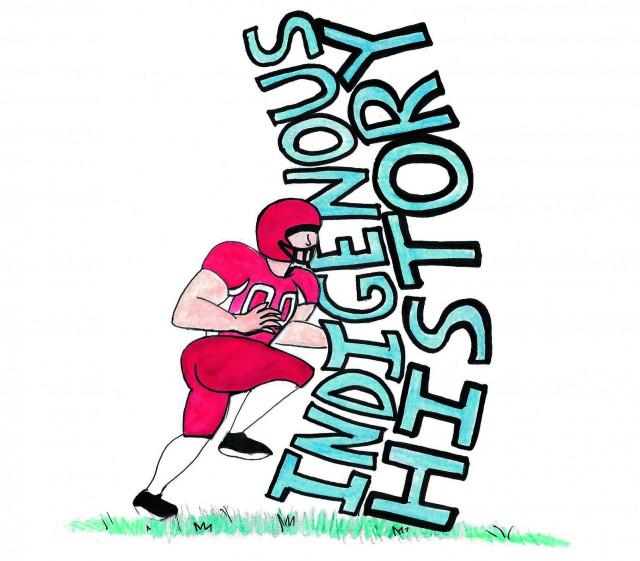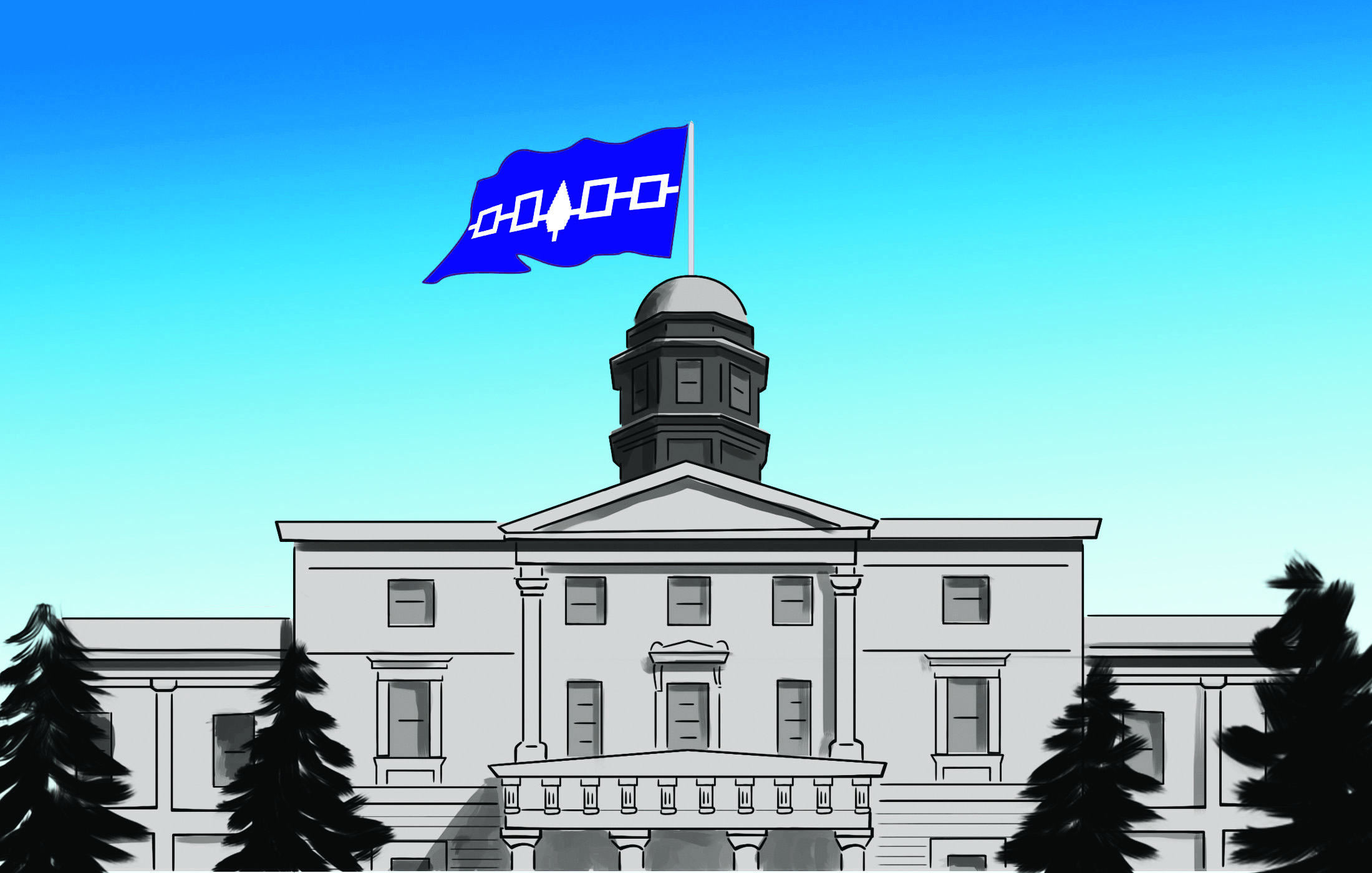September 18 was the 14th annual First Peoples’ House Pow Wow, kicking off the fifth Indigenous Awareness week at McGill. It was a warm summer day, the sun was shining, and students and members of the McGill and Montreal communities of all ages were in attendance. Tents lined the sides of Lower Field, where Indigenous artists sold handmade wares. There was singing, chanting, drumming, dancing, and colourful traditional clothing. As it was nearing noon, a few speeches were made between dances, including an explanation of why some photography was not permitted: the dances was sacred and should be kept as such. One speech by Mohawk Elder Sedalia Kawenno:ta’s Fazio highlighted the work required to share these cultural practices, beginning, “I speak a language that is not mine, so that you may understand me.”
Indeed, an understanding of the cultures and history that shaped the land on which McGill resides is much needed. McGill is located on the unceded traditional territory of the Kanien’kehá:ka – otherwise known as People of the Flint or Mohawk – of the Haudenosaunee Confederacy. Yet, this history is largely absent on campus, in both physical markers and presence in discourse.
I wanted to know what one Mohawk artist who was present at the Pow Wow thought about McGill being on unceded land. He told me that some Indigenous people believe that McGill is poisoning the land. Pointing toward the high-rise buildings in the distance and the concrete McGill buildings next to us, he explained that some are upset not only because their land was taken, but because the environment suffers for it as well.
Meanwhile, official McGill history spotlights its founder, James McGill. Born in Glasgow, Scotland in 1744, McGill was a Scottish “entrepreneur and philanthropist” – a landowner, slave owner, and fur trader – who left a generous legacy of £10,000 to the Royal Institution for the Advancement of Learning, which obtained a charter to found numerous schools. These institutions include McGill University, Concordia University, and the University of British Columbia (UBC), once called the McGill University College of British Columbia. While McGill University has always painted James McGill in a positive light – there is a statue of his likeness at the Y-intersection, after all – it does not widely publicize the origins of the land on which McGill was built.
When McGill University was founded in 1821, it sat on Mohawk land. It still sits on Mohawk land. It has sat on Mohawk land for the past 195 years, yet the University still refuses to acknowledge this fact in any official capacity. On September 12, Kahentinetha of the Bear Clan, an activist and kahtihon’tia:kwenio (woman titleholder) from the Kahnawake Mohawk community near Montreal, sent a seizure notice to McGill University. The notice listed many grievances, among which were the invasion and occupation of Mohawk territory by McGill University and its undermining of Mohawk sovereignty. Kahentinetha demanded in the notice that McGill University stop its invasion, trespassing, and exploitation of the territory, and that it respect the teio’ha:teh (the Two Row Wampum Treaty) as the basis of the relationship between McGill and the Mohawk people.
The seizure notice also demanded that McGill repay the loans it took from the Six Nations Trust Fund in the mid 1800s, along with 195 years of compound interest, the amount of totalling $1.7 billion. The University says that it paid this money back to the federal government, which was the fiduciary trustee of the loan. However, the University should still take these kinds of grievances seriously, and address them as such. If the loan was indeed repaid to the federal government, why not advocate in solidarity with people of the Six Nations and push the government to do its part in getting this money to the people to which it is owed? The fact that the Six Nations peoples have not been repaid is an injustice foundational to McGill’s founding.
Even if one knew nothing about the history of McGill’s land, it would still be obvious that Indigenous histories are not respectfully acknowledged on campus. The McGill Redmen, the name of McGill’s men’s sports teams, was allegedly chosen to reflect the school’s colours and the Scottish history of its founder. However, regardless of original intentions, it has long been associated with derogatory slurs toward Indigenous peoples. A sports article published in The Daily in 1960, which criticized the Redmen for losing a football game, was titled, “Redmen Take Own Scalps.” If the Redmen name was ever anything but a racial slur against Indigenous peoples, it has not been understood that way in over fifty years. The same outcry that has taken place over the Washington Redskins team name applies here; a name like this has no place on a campus that is serious about recognizing and rectifying its complicated and violent history with Indigenous nations.

Moving forward
If bureaucracy, as some have argued, is what prevents the administration from meaningfully addressing the history of McGill’s land, then it is a problem specific to McGill; other universities that have similar administrative structures to McGill have done much more to recognize and rectify their respective histories with Indigenous lands. UBC continues to give recognition to the Musqueam people for the land on which it stands, having signed the Musqueam Memorandum of Affiliation, recognizing its connection to the Musqueam and Okanagan communities. UBC states on its website that “UBC’s Point Grey Campus is located on the traditional, ancestral, unceded territory of the Musqueam people.” Initiatives at McGill to implement a similar land acknowledgement have been stalled and watered down, possibly due to concerns that such a statement would amount to McGill conceding some of its right to the land (despite legal consultation confirming that such a statement would have no legal bearing).
Concordia, our downtown neighbour, has also made visible steps to recognize the contributions of Indigenous peoples and lands to the university’s development. In 2003, Concordia inaugurated the new Richard J. Renaud Science Complex, inviting members of the Mohawk nation to give their blessing. A bronze sculpture called The Emergence of the Chief also occupies a prominent intersection on its Loyola campus, paying “homage to Iroquois heritage and the Mohawk Nation.”
McGill has had some successful initiatives – the recent Indigenous Awareness Week was definitely an example of this – but many more have been stifled by bureaucracy and an unwillingness to act on the part of the administration. Last year, a request to have the Hiawatha Belt Flag flown on special occasions was unsuccessful (although we still manage to fly the royal flag of Canada when the Governor General visits). Similarly, a push to relocate the Hochelaga Rock, which commemorates the Haudenosaunee village of Hochelaga – that many believe once stood on McGill’s current location – to a more prominent location on campus, has also been stalled. McGill has finally introduced an Indigenous Studies minor program, which is a good first step, but many Canadian institutions have had similar programs for years, and also offer major programs. At the last Senate meeting, Provost Christopher Manfredi said that McGill has “an opportunity to be a leader” in the recruitment and support of Indigenous students, as well as the research and teaching of Indigenous issues. If the University has an opportunity to be a leader, it certainly hasn’t taken it.
After 195 years of ignoring the history of the land on which McGill is located, it’s time to acknowledge the important role that Indigenous peoples and their lands have played in establishing McGill, as well as the collaborative role they should be invited to play in the future of this university which sits on their land. It may start with the change of the Redmen name, the relocation of the Hochelaga rock, renaming buildings after significant Mohawk figures, or a simple announcement by the University recognizing that McGill indeed sits on unceded land. Regardless of what action is taken first, one thing is certain: McGill’s current bureaucratic resistance to visible and meaningful recognition of its history with Indigenous peoples and lands is nothing short of shameful.

